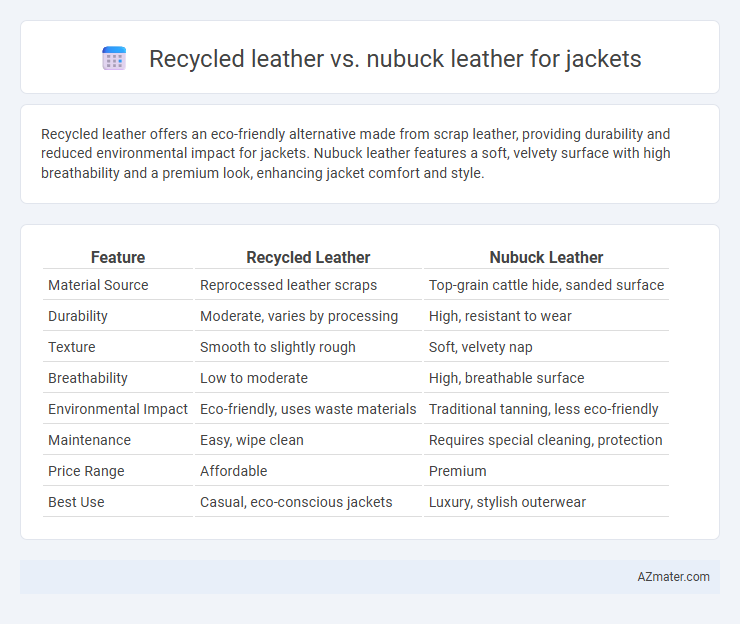Recycled leather offers an eco-friendly alternative made from scrap leather, providing durability and reduced environmental impact for jackets. Nubuck leather features a soft, velvety surface with high breathability and a premium look, enhancing jacket comfort and style.
Table of Comparison
| Feature | Recycled Leather | Nubuck Leather |
|---|---|---|
| Material Source | Reprocessed leather scraps | Top-grain cattle hide, sanded surface |
| Durability | Moderate, varies by processing | High, resistant to wear |
| Texture | Smooth to slightly rough | Soft, velvety nap |
| Breathability | Low to moderate | High, breathable surface |
| Environmental Impact | Eco-friendly, uses waste materials | Traditional tanning, less eco-friendly |
| Maintenance | Easy, wipe clean | Requires special cleaning, protection |
| Price Range | Affordable | Premium |
| Best Use | Casual, eco-conscious jackets | Luxury, stylish outerwear |
Introduction to Recycled Leather and Nubuck Leather
Recycled leather is crafted by reprocessing leather scraps and fibers, offering an eco-friendly alternative that reduces waste and conserves natural resources. Nubuck leather, valued for its soft, velvety texture, is made by sanding the outer grain of full-grain leather, providing durability alongside a distinctive matte finish. Both materials present unique qualities for jacket manufacturing, balancing sustainability with aesthetic appeal and comfort.
How Recycled Leather is Made
Recycled leather for jackets is made by shredding and reconstituting discarded leather scraps, combining them with polyurethane or other binders to form a durable, eco-friendly material. This process reduces waste and lowers the environmental impact compared to traditional leather production. In contrast, nubuck leather is made by sanding the outer grain of full-grain leather, creating a soft, velvety texture but requires more intensive resource use.
The Nubuck Leather Production Process
Nubuck leather is produced by sanding the grain side of a hide to create a soft, velvety surface that retains the natural strength and durability of full-grain leather, making it ideal for high-quality jackets. This unique production process involves carefully buffing the outer layer to achieve a fine, smooth texture without compromising breathability or texture depth. Compared to recycled leather, which is made from bonded leather scraps and may lack uniformity and long-term durability, nubuck offers superior aesthetics and longevity for premium outerwear.
Appearance and Texture Comparison
Recycled leather typically exhibits a more uniform surface with a slightly synthetic texture, making it less breathable and smooth compared to Nubuck leather, which features a soft, velvety nap with a subtle matte finish. Nubuck leather's fine grain and natural pores create a luxurious, tactile experience prized for high-end jackets, while recycled leather often shows minor inconsistencies reflecting its composite material origin. The velvety texture of Nubuck also allows it to develop a personalized patina over time, enhancing its aesthetic appeal, whereas recycled leather maintains a consistent appearance but may wear differently due to its manufacturing process.
Durability and Longevity: Which Jacket Lasts Longer?
Recycled leather jackets offer moderate durability but tend to wear out faster due to their fiber-based composite structure, which is more prone to cracking and peeling over time. Nubuck leather jackets, made from top-grain cattle hides sanded to create a soft, velvety surface, provide superior longevity with greater resistance to abrasion and natural aging. Investing in a nubuck leather jacket results in a longer-lasting garment that maintains its appearance and structural integrity better than recycled leather alternatives.
Eco-Friendliness and Sustainability Factors
Recycled leather jackets reduce waste by repurposing post-industrial scraps and discarded leather, significantly lowering environmental impact compared to traditional leather production. Nubuck leather, derived from sustainably sourced hides and processed using eco-friendly tanning methods, offers durability with a smaller carbon footprint than conventional leather. Both options emphasize sustainability, but recycled leather excels in minimizing raw material use, while nubuck prioritizes responsible sourcing and processing.
Comfort and Wearability for Everyday Use
Recycled leather offers enhanced breathability and eco-friendly softness ideal for everyday wear, while Nubuck leather provides a luxurious, velvety texture that becomes more comfortable over time through natural break-in. Recycled leather jackets typically weigh less and resist cracking, supporting extended use without stiffness, whereas Nubuck's fine grain allows for flexibility but requires more maintenance to prevent staining and wear. Both materials balance comfort and durability, yet recycled leather is preferable for low-maintenance, sustained comfort in daily jackets.
Maintenance and Cleaning Requirements
Recycled leather jackets require gentle cleaning with a damp cloth and mild soap, avoiding harsh chemicals to maintain their eco-friendly integrity and prevent surface damage. Nubuck leather demands specialized care, including regular brushing with a soft nylon brush to remove dirt and avoid staining, alongside the use of nubuck-specific cleaners and protectors to maintain its velvety texture. Both materials benefit from immediate stain treatment and proper storage to extend jacket longevity and appearance.
Price and Value for Money
Recycled leather jackets often offer a more affordable price point compared to Nubuck leather, making them a budget-friendly option while still promoting sustainability. Nubuck leather, known for its luxurious texture and durability, commands a higher price but provides excellent long-term value due to its premium quality and wear resistance. Choosing between recycled and Nubuck leather ultimately depends on balancing initial cost with desired longevity and eco-conscious benefits.
Choosing the Best Leather for Your Jacket
Recycled leather offers an eco-friendly alternative with durability and a unique texture, making it a sustainable choice for jackets, while Nubuck leather provides a soft, velvety finish with a premium look and enhanced breathability. When choosing the best leather for your jacket, consider the environmental impact, maintenance requirements, and desired style, as recycled leather requires less maintenance but may age differently compared to the luxurious feel and classic appeal of Nubuck. Both leathers offer distinct benefits, so selecting between recycled leather and Nubuck depends on personal preference for sustainability versus a high-end aesthetic.

Infographic: Recycled leather vs Nubuck leather for Jacket
 azmater.com
azmater.com